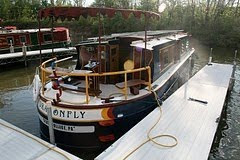I mentioned in an earlier post that, when I travel, I like to read books that relate to my travel destination.
With that in mind, here are a few more books from our shipboard bookshelf. And if you have suggestions
for other good reads, I’d love to hear them!
 |
| A towboat named for James Fenimore Cooper's hero |
A collection of five novels spanning colonial American history from the French and Indian War to the Louis
and Clark expedition. I read
The Pathfinder (chronologically the first story), which involves sailing ships engaged in daring maneuvers on Lake
Ontario, while we visited Fort Oswego and steeled ourselves to venture out on that Great Lake for our first major crossing. I read The Prairie (chronologically the last story) as we floated down the Mississippi, ogling prairie wildflowers.
You probably remember these books for the bloody battles with hostile Native Americans (or for the movie starring Daniel Day Lewis, which, though enjoyable as a spectacle, has numerous plot points you'll find nowhere in these books and (ridiculously, if you know anything about native vegetation of upstate New York) was filmed in North Carolina. What jumped out at me on this reading was the passionate conservation message. The protagonist, hunter Natty Bumpo, loves wilderness, and as American settlers chop down trees, slaughter passenger pigeons and bison, and otherwise despoil the landscape, he flees westward.
You probably remember these books for the bloody battles with hostile Native Americans (or for the movie starring Daniel Day Lewis, which, though enjoyable as a spectacle, has numerous plot points you'll find nowhere in these books and (ridiculously, if you know anything about native vegetation of upstate New York) was filmed in North Carolina. What jumped out at me on this reading was the passionate conservation message. The protagonist, hunter Natty Bumpo, loves wilderness, and as American settlers chop down trees, slaughter passenger pigeons and bison, and otherwise despoil the landscape, he flees westward.

.jpg)

































